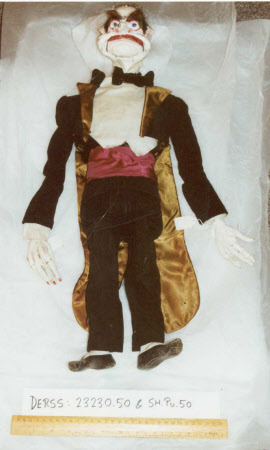Marionette
Category
Toys
Date
Unknown
Materials
Wood, cord, vinly, cotton, corduroy, satin, metal and nylon thread
Measurements
650 mm (height)
Order this imageCollection
Sudbury Hall Museum of Childhood, Derbyshire
NT 661584
Summary
One of the puppets made for and used by the ‘Lilliput Marionette Theatre’. A marionette puppet of an evil-looking man in evening wear, without a control, but with strings made from nylon thread. He has a carved wooden head with pointed ears, prominent nose and eyebrows and painted facial features. His mouth can be opened and closed by means of the strings which are attached where it hinges on the lower side. There is a large hole at the neck edge of the body, and his head and very long neck are joined inside this hole to the middle of his body by means of a thick piece of cord which is attached at each end with metal loops. He is jointed at the shoulders, elbows, wrists, waist, knees and ankles with metal joints. His body is made from wood, with modelling material hands, which are painted white with red lines down the backs and red fingernails and are cracked in places. He has white skin with brown lips, a red tongue, and green eye shadow. His hair and bushy black eyebrows are made from black mohair glued on. He also has a few strands of green mohair in his hair. He is wearing black corduroy, short-waisted tailcoat lined in gold, with a stand-up collar and brown satin lapels over a white cotton shirt which has a wing collar. He is also wearing a dark pink satin cummerbund and a black vinyl bow tie.He has black corduroy trousers, his feet are painted white, and his shoes are made from black leather glued on. His clothes are slightly dirty.
Provenance
Donated to the Museum of Childhood by Mr E Hellawell in 1982.
